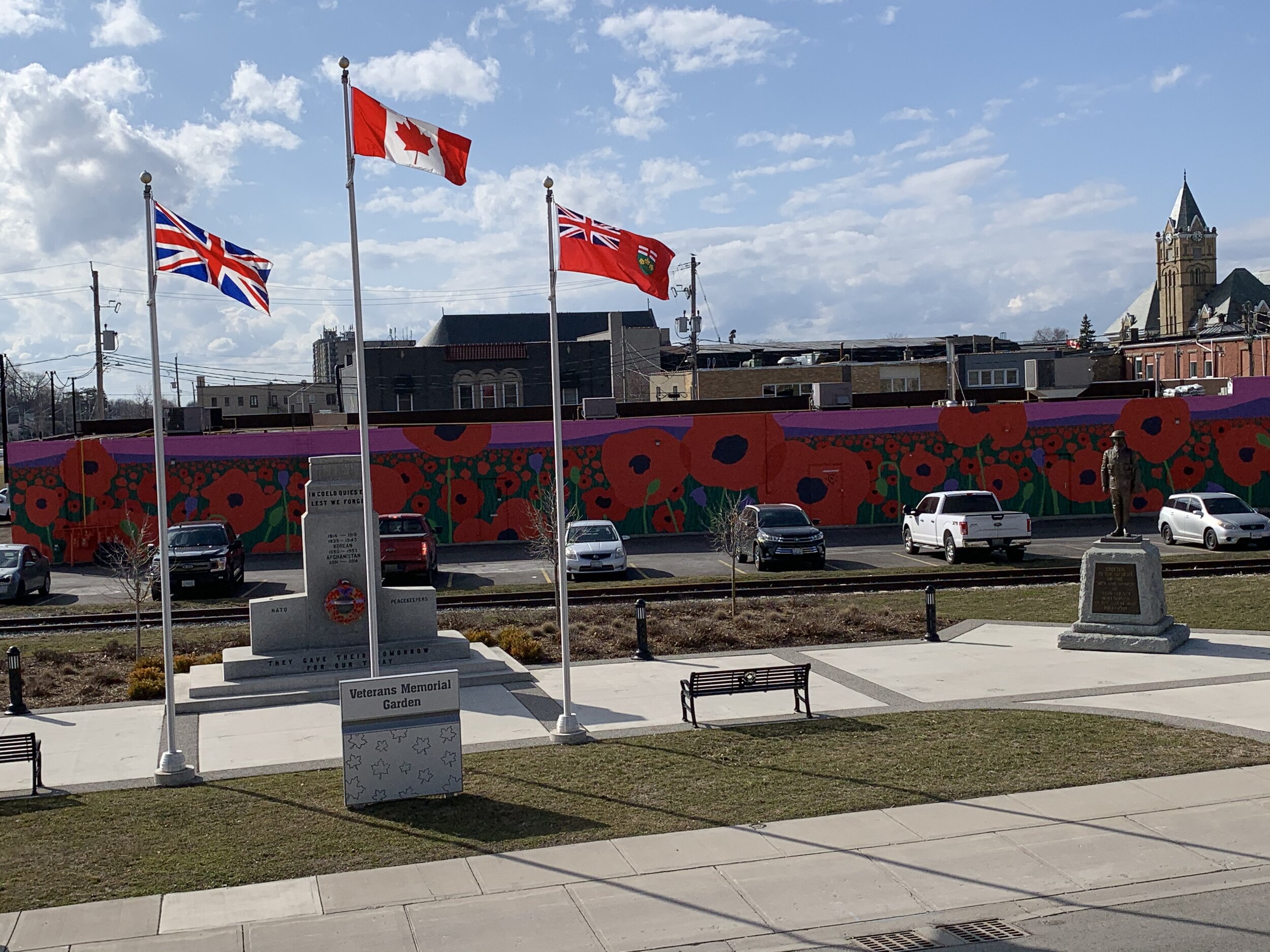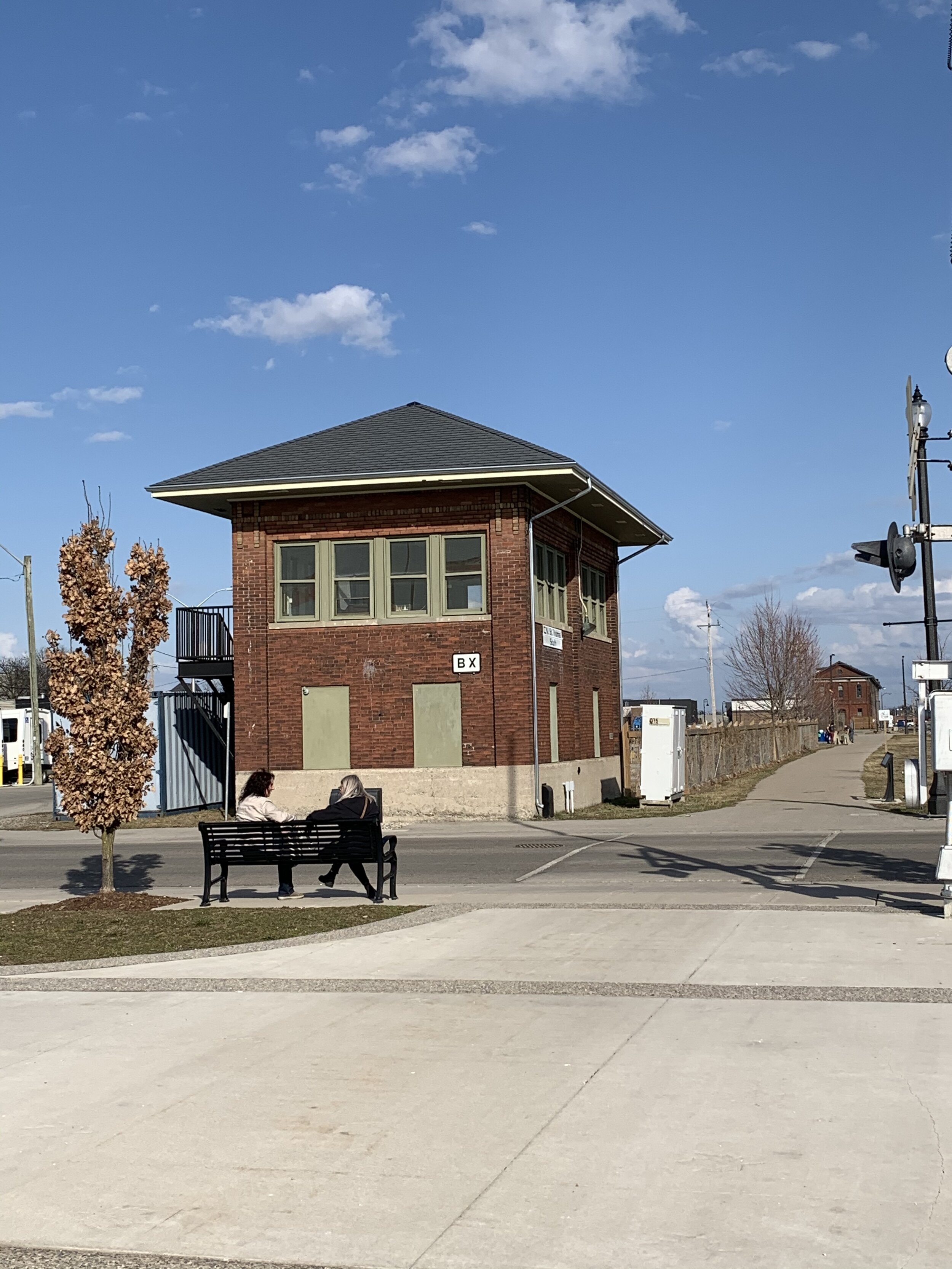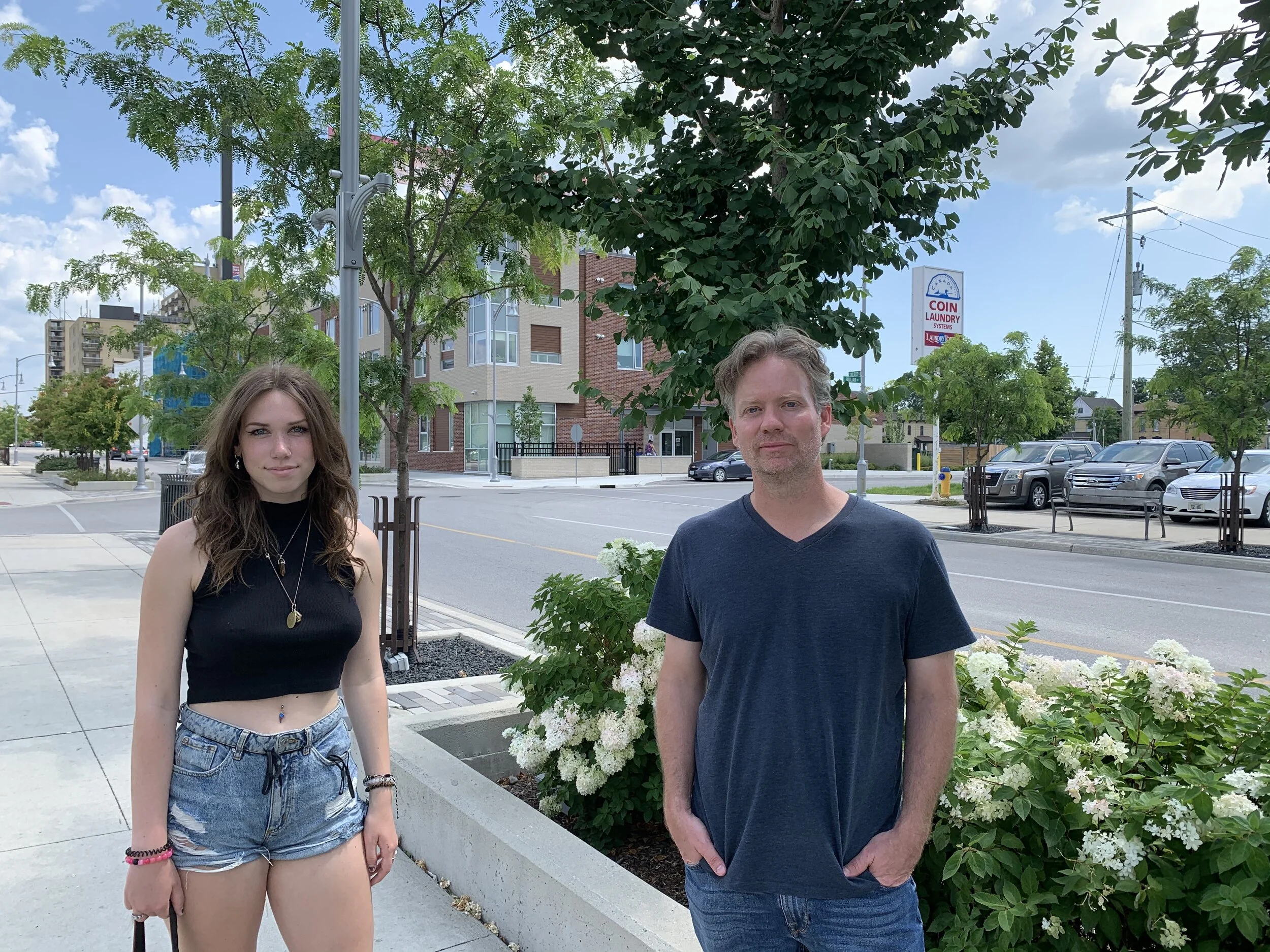Reinventing St. Thomas
Emily Stage & Andrew Gunn of young & free press walked a few blocks recently in & around downtown St. Thomas. Emily took photos & later Andrew wrote this corresponding blog post. Currently we are working in collaboration with the St. Thomas Economic Development Corporation, St. Thomas Downtown Development Board, St. Thomas & District Chamber of Commerce, St. Thomas Elgin Home Builders’ Association, and Elgin County to highlight all the ways that there is ‘So Much More Life’ in the community, part of an ongoing campaign to feature what the area offers. Over the past year, our team has introduced more than $3M in projects supported by private sector donors, principally the Estate of Donna Vera Evans Bushell. We are excited to chart how these new initiatives are evolving together with the work of local leaders, business owners & citizens to reinvigorate the city after a lengthy period in which the community lost some monumental things. Cities rise, fall, and rise again, and the process can be incredibly beautiful.
Reinventing St. Thomas
Essay by Andrew Gunn with photos by Emily Stage
City-building requires vision, funding and resiliency. All three elements need to come together continuously, especially in communities where one, two or all three have been lacking for years and the cultural atmosphere has dissipated. How do we know if a city is building toward something positive or negative? The story is there in every block, neighbourhood, and commercial district. Walking, cycling and skateboarding are keys to reading these stories and understanding the messages. Get out of the car and move at street level. Interact with others. Listen to the bits of conversation that float by. We love the idea of psychogeography, mapping a community by the mood set in each distinct area. There is so much happening if one takes the time to consider the details. We like to combine active transportation with sharp senses.
St. Thomas is roughly a decade into a twenty-five year rebuild following the loss of some economic and cultural cornerstones. Beginning in the 1970s and 1980s, the community absorbed the demise of the railway industry, the loss of Alma College, the shuttering of the St. Thomas Psychiatric Hospital, and then the collapse of traditional auto manufacturing, including the closure of the Sterling Truck plant, Ford assembly plant, and many others. Thousands of jobs disappeared. Sections of downtown felt abandoned, as businesses shut down and elementary and secondary schools closed with students being relocated to buildings old and new outside the core. Around 2010, the city felt like a mini-version of Detroit, similar to Windsor or Brantford or scores of other small cities around the Great Lakes where assembly lines once provided steady employment. Those days have faded and we are in the midst of the great reinvention.
Recently we explored a portion of the Whistlestop Trail in downtown St. Thomas. This is a walking and cycling trail established along the historic London & Port Stanley Railway Corridor. We focussed on what amounts to three or four blocks, a compact area that is gradually evolving into something fascinating. The area has changed significantly over the past ten years, and there is a lot of work still to do to help the downtown flourish. Remember: vision, funding, and resiliency.
For many years, the London & Port Stanley Railway Corridor was a neglected part of the downtown landscape. Areas like this can be a source of regeneration, however, if one thinks of the potential of all the adjacent properties. Back in 2012, I was serving as the Trustee of the Estate of Dorothy Palmer, and arranged a donation of $575,000 from the Estate to the City of St. Thomas to reinvent this section of downtown.
There were a lot of puzzle pieces to consider, including property boundaries, the railway line, and how the space would be configured. Ultimately, we arrived at a civic space redevelopment that focussed on three things: first, the St. Thomas Elgin Home Builders’ Association would construct a replica of the former London & Port Stanley Railway Station on the site just north of Talbot Street; second, a section of railway track that had been removed would be reinstalled to allow the Port Stanley Terminal Railway to operate a tourist train from downtown St. Thomas to Port Stanley; and third, a trail would be established from Kains Street to Wellington Street and east to the CASO Station to facilitate walking and cycling with benches, trees, and gardens added throughout this revamped green-space.
The hope was that, once we took this major step, new investment would come. Empty properties would be purchased and renewed. Additional cultural assets would be imagined and installed. Active transit would be prioritized. All of this has happened gradually over the past eight or nine years. The benefits are starting to show, but there remain countless things still to improve.
In 2017, the new Veterans Memorial Garden was established between Talbot and Centre streets. There are several stand-out features in the space, including monuments and statues commemorating those who served in the First World War, Second World War, Korean War, and most recently in Afghanistan. This was not the original plan when the green-space was designed in 2012 – at the time, we were contemplating night markets and special events in the area – but part of city-building is listening to other community partners and adapting plans. The Veterans Memorial Garden was strongly supported by the City and local donors.
In the spring of 2020, our team at young & free arranged funding from the Estate of Donna Bushell to support the ‘Track to the Future’ mural project in collaboration with Railway City Tourism. The opportunity came up to add artwork on the east-facing wall of 7 Princess Avenue, which is owned by local businessman Andy Lerikos. The wall forms the backdrop of the Veterans Memorial Garden. We engaged internationally-acclaimed artist Andrew Lewis to paint a mural, and he designed a field of poppies. Titled ‘Heroes’, the stunningly beautiful artwork is the perfect complement to the site, encouraging everyone who walks by to contemplate the sacrifices of others. This has quickly become a local landmark.
City-building requires collaboration, and we have been fortunate to have private property owners work with us in this spirit. As we look around the space, we see long-standing businesses like Legends Tavern, as well as new start-ups like Old School Pizza. There are a number of offices in the area and a mix of residential uses. When we sit and observe for a while, there is a lively mix of people from all walks of life passing by, from those struggling with homelessness and addiction to teenagers riding by on skateboards and bikes to business owners popping in & out of buildings. The downtown should be a safe and vibrant place for everyone. Yes, there are occasionally needles on the ground. Certain properties require significant repairs. Aesthetic interest comes and goes. Overall, though, the trend is positive. We need vision, funding, and resiliency – and at least another fifteen years to reinvent the area completely.
One ongoing conversation in St. Thomas is the merit of whether to continue to refer to the community as the ‘Railway City’ – while the history of the community is connected deeply with the rail industry, there is minimal train activity at present to justify the nickname. There remain, however, some remarkable buildings and features, and the influence of the railways is obvious in how the city is laid out.
In this particular area downtown, the BX Tower stands prominently – built around 1917, the tower remained in use until the 1980s, a control point for managing rail traffic where the Canada Southern Railway tracks cross with the London & Port Stanley Terminal Railway line. The building is rarely open to the public, but if one gets a chance to peek inside, the vantage point of former operators is revealed – looking out over where the tracks crossed, there are a series of levers that were once connected to the track switches. We wonder how the site could be activated as a tourist site in the future – right now, this is one spot that feels dormant in the area. Outside the tower, though, community gardens have popped up on the former site of the railway tracks, a project of nearby Destination Church. We have noticed raised garden beds across the street, too, for residents of the attractive new Seasons Retirement Community.
Visitors can follow the ‘Palmer Memorial Walkway’ to the east and discover the CASO Station and Elgin County Railway Museum, two other examples of local railway history. The ongoing COVID-19 pandemic has kept both sites mostly closed to the public for the past year, but each building offers distinctive architecture and compelling spaces for special events.
Downtowns are essentially a collection of interconnected private and public spaces. Every spot can be viewed as an opportunity. Take the alleyway that connects Talbot Street to the Moore Street parking lot. Owned by the City, this little path and greenspace sat blank for years, grey walls towering over anyone walking through. Our team loves this kind of urban terrain and imagining how artwork can redefine the way that residents and visitors experience the area. As part of the ‘Track to the Future’ mural project, we engaged artist MEDIAH to transform the walls – the result is the spectacular ‘WILLOWSHEEN’ mural, a 4300 square foot work of art that contemplates the impact of technology on the natural environment. Post-pandemic, we imagine small events in this space, potentially harvest dinners, pop-up markets or mini-concerts.
One of the hidden secrets of the ‘Track to the Future’ project is that our aim is for people to be able to view one mural and always see another one from the same spot. The goal is to promote active transportation downtown in subtle ways, encouraging people to walk, bike and skateboard throughout the area. We need more bike lanes and trails to make this happen safely and successfully, but those pieces are beginning to come together. The City has developed a Complete Streets Policy to guide this development. The new Railway City Skatepark is located by the Joe Thornton Community Centre (sit for a while downtown and take note of all the skateboarders that roll through). Local home-builders have been working with the municipal planning department to connect trails from new residential developments on the outskirts of the city with the paths and walkways that lead downtown. This is a promising work-in-progress.
Generating movement is one key to rejuvenating a city. There are so many ways that we can help promote walking, cycling and skateboarding. Interestingly, this involves continuing to rethink the identity of the community as the ‘Railway City’, as the former railway corridors, lands and assets keep being turned inside-out to accommodate current and future needs. Perhaps the most remarkable example of this is the St. Thomas Elevated Park at the west end of the city – the park is a walkway built on top of the Michigan Central Railroad bridge eighty feet above the Kettle Creek valley. Over the past few years, the site has become one of the primary tourist destinations in all of southwestern Ontario.
Perhaps St. Thomas is starting to surprise people. If visitors can experience the local culture and feel changed, even a little bit, then we are starting to make progress. We want people to return home after travelling through and remember the strange adventures only possible in the Railway City — there is even a mural titled ‘Strange Adventures’ by Denial that hints at this possibility.
There are a number of buildings that have been restored, renovated or built new near the Whistlestop Trail over the past ten years. One notable heritage structure is the Princess Ave Playhouse, which was designed by architect Neil Darrach and built in 1907. With the support of the Dorothy Palmer Estate and many other local donors, the building was restored between 2012 and 2014 and serves as the home of the Elgin Theatre Guild. Quietly the venue has hosted some fantastic concerts over the past number of years, including shows by Bruce Cockburn, Sloan, The Ennis Sisters, Joel Plaskett, Steven Page, and Hawksley Workman. Beyond the COVID-19 pandemic, we would love to build up a robust schedule of concerts for the venue.
A notable new build in the area is the Emergency Shelter for Violence Against Women Services, Elgin County. The modern, efficient facility opened in fall 2016, supported by provincial funding along with over $1M in private donations from the community. On the social services front, there is also the Inn Out of the Cold, which operates currently in the Central United Church on Wellington Street. Recently, however, the City announced the new Compassionate Community Strategic Objective, which focusses on adding new resources to support the homeless and other vulnerable community members. The multi-faceted approach includes some notable investments: first, the City acquired the building at 10 Princess Ave for use as a 24-hour emergency shelter for the homeless, and the Inn Out of the Cold will relocate operations to this site; second, sixteen micro-apartments will be built on the second floor of the municipal transit building at 614 Talbot Street to provide supportive accommodations for those transitioning out of homelessness. Construction is underway on both projects, and each one is expected to be in use later this year.
The City has also entered into a Memorandum of Understanding with Indwell to collaborate on the micro-apartment project in the Transit building as well as a new supportive housing development at 230 Talbot Street. There is an additional proposal that could see the St. Thomas Elgin Food Bank relocate to a new building at the corner of Ross and Centre Street, which would include up to 48 supportive housing units.
One of the challenges that many small cities face is facilitating infill projects. These types of developments are difficult because the focus is typically on neglected or vacant properties within the existing built environment, and there are many reasons why such sites are under-utilized. There could be soil contamination, heritage easements, or a variety of other legal or urban planning issues.
In St. Thomas, we are fortunate that a number of new investments are taking shape! Walking south from downtown along the Whistlestop Trail, residents and visitors will note two impressive infill projects just south of Wellington Street. To the west, there is a condominium housing development by Donwest Homes featuring a series of lovely red-brick dwellings; to the east, there is the massive Alma College Square project by Patriot Properties, which will eventually feature three luxury apartment buildings. All of these residential units are close to the trail and within easy walking distance of the downtown core. Our little dream is to see more and more of this happen in St. Thomas, adding residential density to make the downtown busier and more vibrant. There are still several lots in the area that could be re-imagined in the future.
Every now and then we get asked why we care about city-building, particularly the fate of downtown areas. Our answer is that the distinctive identity of each community is to be found in the downtown, and this evolves over time. We recognize the significance and practicality of box stores and subdivisions, and know that many people like these commercial and residential fits. Still, the downtown is what defines a place, and we think that community leaders can makes decisions that result in a positive or negative trend.
For St. Thomas, the trend is positive, and we love to see how more and more people are finding ways to invest in the community. With vision, funding, and resiliency, the city will continue to grow, and the ‘Railway City’ may just become more interesting than ever before. The wonderful thing from our perspective at young & free is that everyone can participate in the story. One easy way to start is to walk, bike or skateboard along the Whistlestop Trail and look closely at what is happening. We hope that everyone feels welcome to do so.
Emily Stage & Andrew Gunn of young & free press at the corner of Wellington and Ross streets, a couple blocks east of the Whistlestop Trail in St. Thomas. Note the gorgeous mural in the background by artist Meaghan Claire Kehoe. Wander the city and discover all the artwork … the ‘Track to the Future’ mural project is continuing in summer & fall 2021 with new large-scale pieces and a fun augmented reality app!
















